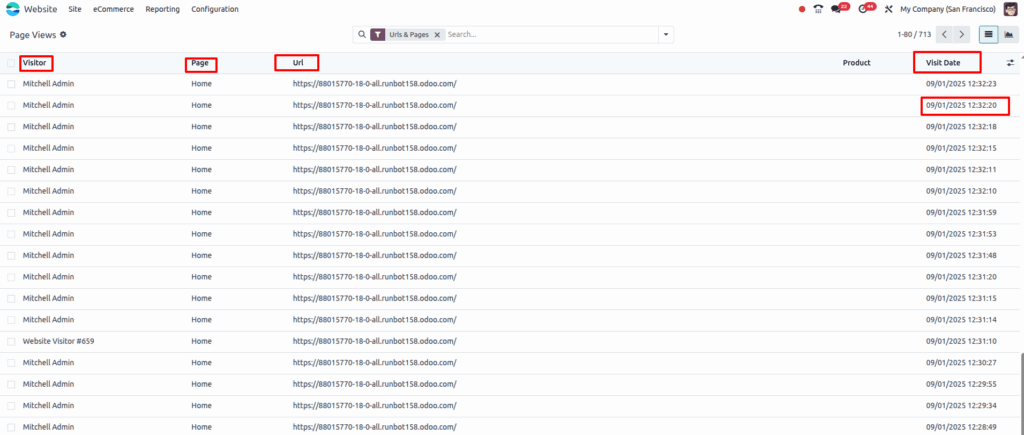Website Management in Odoo 18
Odoo Website is a simple yet powerful tool that allows businesses to design and run professional-looking websites without needing any coding knowledge. Using its drag-and-drop editor and ready-made content blocks, anyone can quickly build pages such as Home, About Us, Services, Product Catalogues, Blogs or Contact forms. The Website app is fully connected with other Odoo modules like CRM, Sales, eCommerce and Helpdesk, so the company can manage its online presence, sales, marketing and customer support from one place. It also supports multiple languages, AI-based translation, SEO features, live chat, customer portals and website analytics, making it a complete digital solution for Indian as well as global businesses
Key Features
- Visual drag-and-drop editor for easy page building without coding
- 80+ ready-made content blocks including banners, galleries, pricing tables, forms, and testimonials
- Create and customize various content pages Home, About Us, Services, Products, Blog, Contact, FAQ, Pricing, Portfolio, Landing Pages, Event Pages and Legal pages
- Mobile-responsive design for optimal viewing on all devices
- Full integration with Odoo apps like CRM, Sales, eCommerce, Marketing and Helpdesk
- Built-in SEO tools for editing meta tags, URLs and automatic sitemap generation
- AI-powered multilingual support with automatic website translation
- Manage multiple websites from one backend with unique branding and content
- Live chat and smart contact forms to engage visitors and capture leads
- Secure customer portal for orders, invoices and support tickets
- Inline image editor and access to free high-quality images via Unsplash
- Upload and embed downloadable files such as PDFs and brochures
- Website analytics and visitor tracking with integration options for Google Analytics
- Complete eCommerce capabilities including shopping cart, one-page checkout, product variants and AI recommendations
- Store locator with map view for physical locations and pick-up points
- Reusable page templates and content blocks for fast website creation
- Fast loading speeds with automatic image optimization and caching
- Flexible hosting options on Odoo cloud or self-hosted environments
- Access to Odoo App Store for adding extra website and business functionality
Workflow diagram
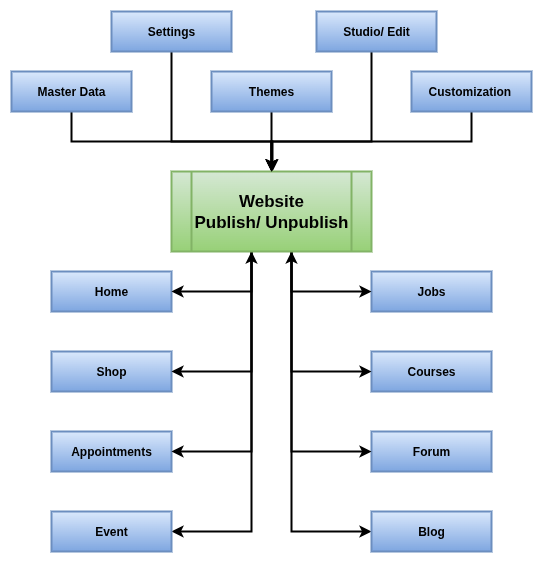
Website Master Management
- Blogs
- Tags
- Tag Categories
- Forums
- Ranks
- Tags
- Badges
- Close Reasons
- Mailing Lists
- Moderation Rules
Website configuration Management
- Website
- website menu
Website Management
- Home page
- Menu edit
- Content
- Pages
- Products
- Events
- Courses
- Appointments
- Jobs
Website Reporting Management
- Visitors
- page Views
Website Master Management
Blogs
Overview
The Odoo Blog application helps businesses create, manage and publish professional blogs directly from their website. It is designed with a simple drag-and-drop interface, SEO optimisation tools and multi-language support, making it easy for companies to share content, attract visitors and improve their online visibility. Blogs can be enriched with images, videos, snippets and calls-to-action, and are fully integrated with Odoo’s website, eCommerce and marketing tools. This allows businesses to use blogging as an effective channel for branding, lead generation,and customer engagement
Process Flow
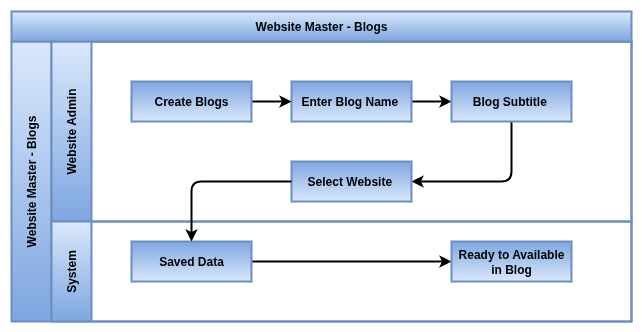
Business Rules / Key Features
- Each blog must have a Blog Name
- A Blog Subtitle is optional and used for descriptive purposes
- Create and publish unlimited blog posts with categories and tags
- Each blog can contain multiple blog posts
- Only blogs linked to published posts will appear on the website
- Manage multiple blogs (Ex, News, Product Updates, Knowledge Base)
- Organise posts with categories for better navigation
- Schedule blog posts for future publishing
- Integrate blogs with website menus and navigation
- Drag-and-drop editor with images, banners, videos and snippets
- Share posts directly on social media channels
- Track performance using website analytics and visitor tracking
- Integration with email marketing for newsletters and campaigns
Screenshot

Blog Tags
Overview
Blog Tags in Odoo are used to categorise and organise blog posts with descriptive keywords. They make it easier for visitors to find related content and for businesses to improve the visibility of their posts in both website navigation and search engines. Tags also help group posts across different categories, enhancing user experience and content discoverability
Process Flow
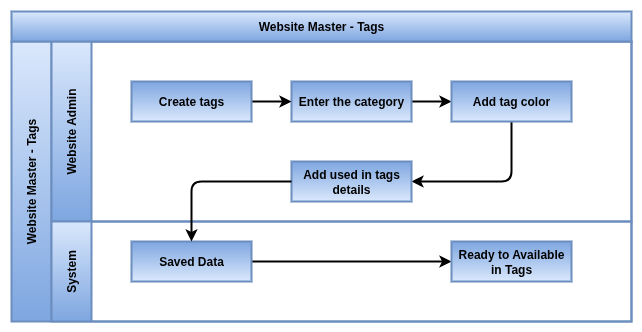
Business Rules / Key Features
- Each tag must have a unique Name, define unlimited tags to label blog posts
- A tag may optionally belong to a Category
- A Color can be set to visually distinguish tags (optional)
- A tag can be used in one or more blog posts
- Website URLs where the tag is used are tracked for reference
- SEO optimization fields may be configured but are optional
- Use multiple tags per blog post for better classification
- Improve navigation by letting visitors click on a tag to see all related posts
- Help search engine optimisation (SEO) by providing relevant keywords
- Easy to create and manage directly from the backend
- Support for multi-language translations of tags
- Tags are fully integrated with blog search and filtering
Screenshot

Tags Category
Overview
Blog Categories in Odoo are used to classify blog posts into broader groups, making it easier to structure content for readers and manage it efficiently. While tags allow flexible, keyword-based organisation, categories act as higher-level groupings such as News, Events, Tutorials, Reviews. Categories help visitors quickly browse posts of interest and improve the overall navigation of the website.The Tag Categories master is used to group tags under a common classification. This supports better backend management and structured filtering for blog content.
Process Flow
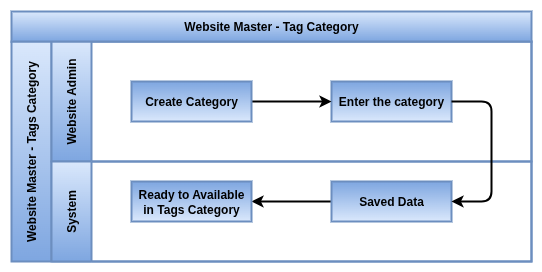
Business Rules
- Each tag category must have a unique Name
- A tag category can contain multiple tags
- Each tag can belong to only one category
- Tag categories are optional but recommended for organizing large tag sets
- Define multiple categories to group blog posts logically
- Each post can be assigned to only one category
- Categories appear as navigation filters in the blog module
- Enhance SEO with category-based URLs
- Support multi-website: categories can be assigned per website
- Multi-language support for category names and descriptions
Screenshot

Forums
Overview
The Forum in Odoo Website is an interactive platform where businesses can create online communities to engage with customers, employees, or partners. It allows users to post questions, share knowledge and collaborate around topics of interest. Forums can be public or private, supporting both customer-facing Q&A portals and internal knowledge-sharing spaces. The platform is tightly integrated with other Odoo apps, such as Website, eLearning and Helpdesk, enabling smooth interaction, gamification and content-driven engagement
Process Flow
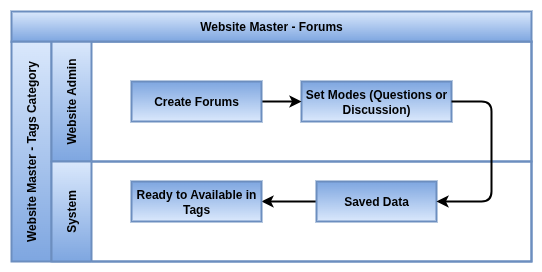
Business Rules
- A unique forum name is required
- Create and manage multiple forums (e.g., Support Forum, Community Discussions, Internal Q&A)
- Each forum must be linked to a specific website
- Description (optional) can be shown on the site to guide users
- A default sorting method (e.g., Newest, Most Active) can be configured
- Changes made in one forum do not affect other forums
- Categorise forums by subject, audience, or purpose.
- Users can post questions, provide answers and comment on discussions
- Voting system for upvoting/downvoting questions and answers
- Gamification and karma points to reward active contributors
- Ability to mark “Best Answer” to close discussions
- Moderation tools: approve posts, flag inappropriate content, manage spam
- SEO-friendly URLs for forum posts and questions
- Integration with Website menus for direct navigation
- Access rights: configure who can ask, answer or moderate
- Email notifications for followers (new questions/answers)
- Multi-website and multi-language support
Screenshot
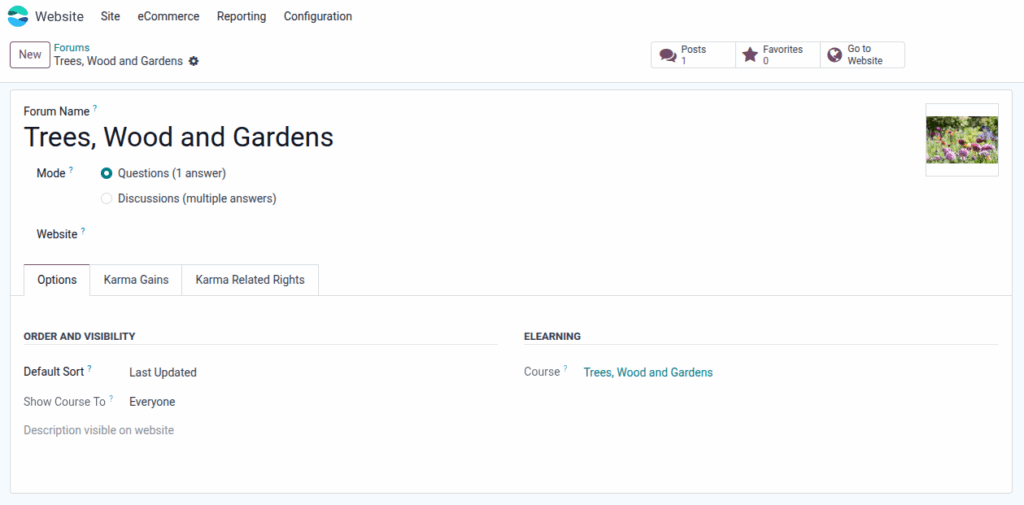
Ranks
Overview
In Odoo Forum, Ranks define user reputation levels based on their earned karma points. As community members participate (asking, answering, voting), they gain karma. Once thresholds are reached, they are promoted to higher ranks with more privileges. This gamification system motivates users to contribute more actively and maintain a healthy community
Process Flow
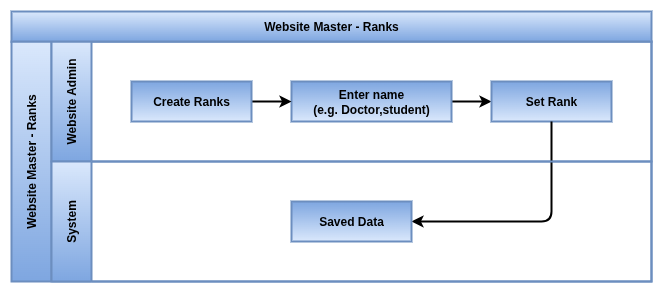
Business Rules / Key Features
- A unique rank name is required
- Define multiple user ranks (Ex, Beginner, Contributor, Expert, Moderator)
- Set minimum karma points required to achieve each rank
- Users can hold only one rank at a time, based on their current karma
- Descriptions can be added for clarity or motivation
- Ranks are informational only and do not control permissions
- Ranks automatically update as users earn more karma
- Control permissions by rank (ability to ask questions, answer, comment, vote or moderate)
- Encourage user engagement by rewarding helpful activity
- Provide transparency to users about what actions unlock higher privileges
- Integrated with gamification rules (badges, karma, achievements)
- Helps reduce spam and low-quality posts by restricting features to trusted ranks
Screenshot

Forum Tags
Overview
In Odoo Forum, Tags are used to categorize and organize questions, making it easier for users to search, filter and navigate discussions. Tags help group related content across different forums or topics, ensuring better visibility and faster answers for the community
Business Rules
- Each tag must have a unique name
- Tags can be assigned to one or more topics
- Tags can be linked to specific forums
- Colors can be set to visually identify tags
- Users may create or modify tags if their karma level permits
- Tags enhance search, filtering, and SEO
- Tags improve searchability by allowing users to filter questions by topic
- Tag visibility is managed based on forum setup and user permissions
Screenshot

Badges
Overview
In Odoo, Badges are part of the Gamification & Forum system. They act as rewards or recognition for users who contribute to the community or achieve specific milestones. Badges increase engagement, encourage quality participation and help identify knowledgeable members in the forum.Badges are displayed on user profiles and posts.
Process Flow

Business Rules / Key Features
- Each badge must have a unique name
- Descriptions explain the reason or criteria for the badge
- Icons/images should be added for visual recognition
- Badges can be awarded automatically (via rules) or manually (by moderators)
- Badges are visible on user profiles and improve user motivation
- Badges are awarded automatically based on karma rules, achievements
- Encourage active participation in forums by rewarding contributions like best answers, helpful votes or frequent activity
- Users can earn multiple badges and display them on their profile
- Badges help build trust and credibility in the community
- Badges can be linked to specific goals or challenges
Screenshot
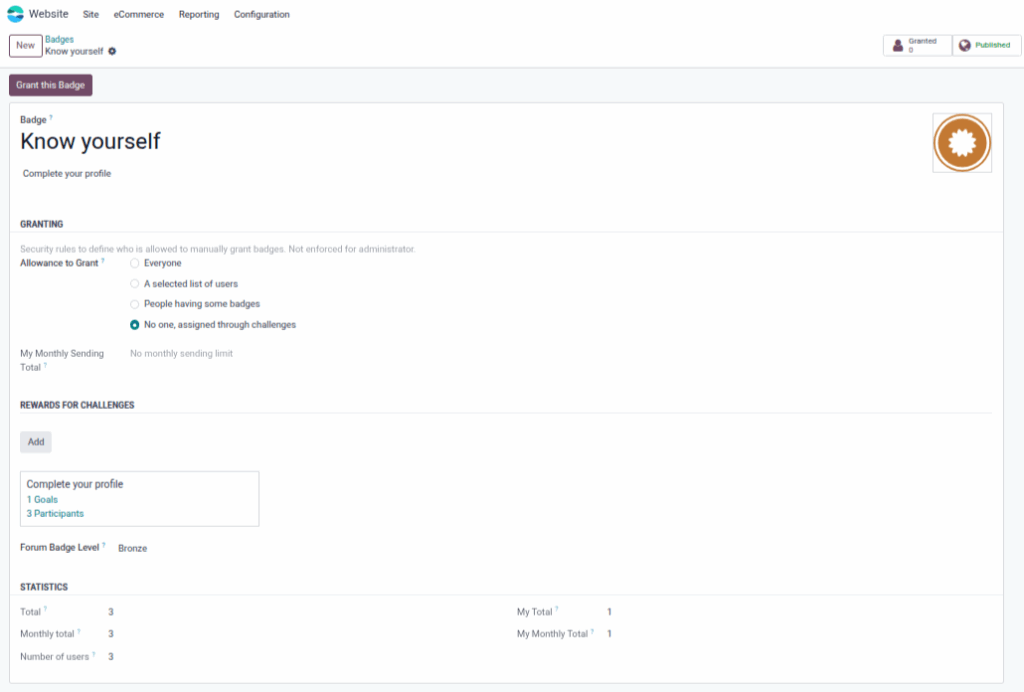
Close Reasons
Overview
Close Reasons are predefined explanations that moderators choose when closing a forum topic. They help communicate clearly to users why a topic was closed and support consistent moderation.
Process Flow
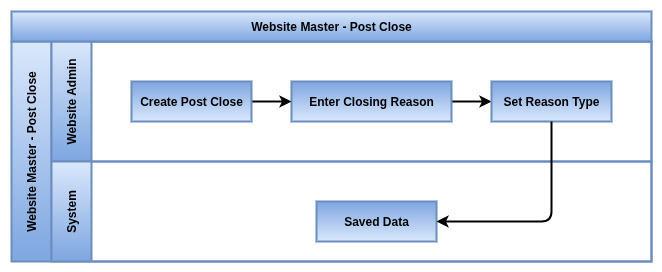
Business Rules
- Each close reason must have a unique title or label
- Moderators select a close reason when closing a topic
- Reasons should be clear and respectful (e.g., duplicate, off-topic, solved)
- Close reasons can be customized or extended by admins
- The selected reason is visible to users when the topic is closed
Screenshot
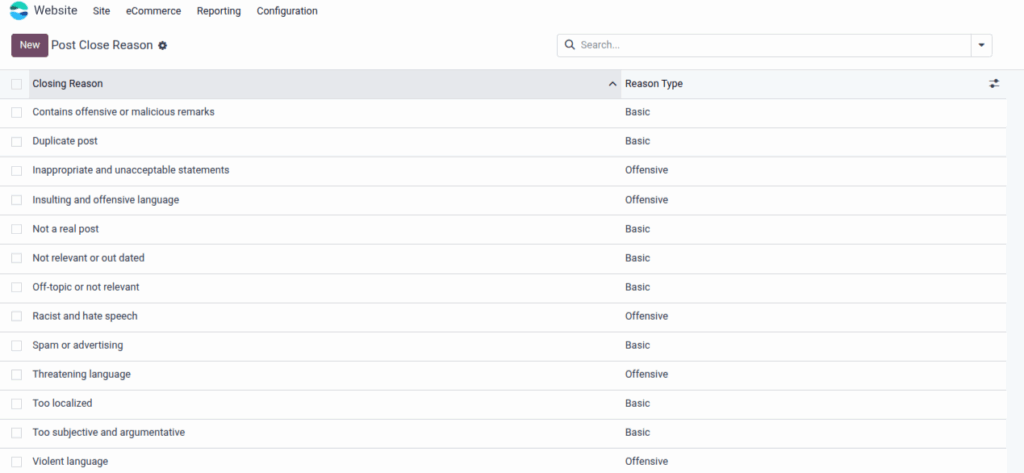
Mailing List
Mail Groups
Overview
Mail Groups in Odoo are email-based discussion groups that allow users to communicate via a shared mailing list. Members can send emails to a common alias, which distributes messages to the group. Mail Groups can be public or private, moderated or open, helping teams or communities stay connected via email without needing to log into the forum interface.
Process Flow
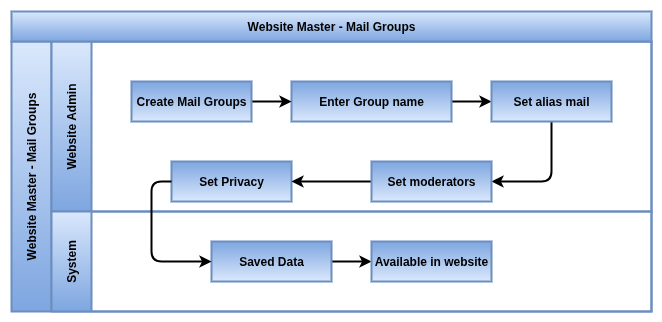
Business Rules
- Each mail group must have a unique Group Name.
- An Email Alias is mandatory and must be unique within the domain.
- The email alias format follows [alias]@[domain] (e.g., public_group@test.com).
- Description provides context about the group’s purpose and is visible to members.
- Groups can be set as moderated or open
- If moderated, moderators are assigned who approve or reject messages.
- Privacy settings define access
- Everyone – open to all users.
- Members only – only subscribed users can participate.
- Selected group of users – restricted to specific users/groups.
- Notify Members option controls if members get email notifications of new posts.
- Group Guidelines can be provided to set expectations and rules for communication.
- Only authorized users can moderate or change privacy settings.
- Members subscribe/unsubscribe according to privacy and moderation rules.
Screenshot
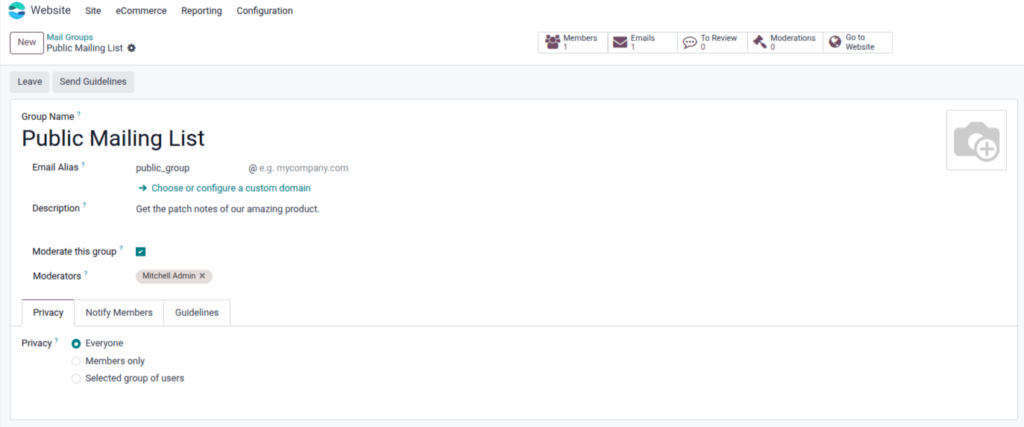
Moderation
Overview
Moderation in Odoo Mailing Lists allows administrators to control email traffic by defining rules that allow or ban specific email addresses or domains. This helps maintain the quality and security of the mailing group by filtering unwanted or malicious content, ensuring only trusted participants can post.
Process Flow
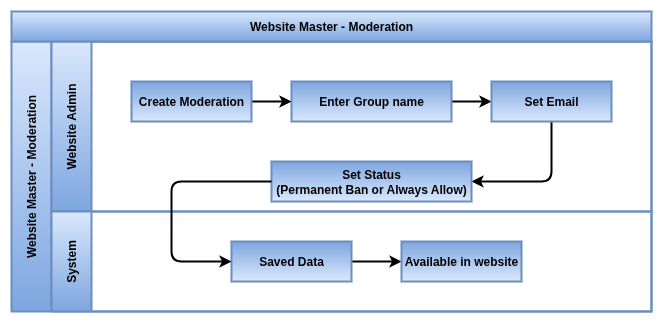
Business Rules
- Moderation rules apply to specific mailing lists or mail groups.
- Each rule must specify the email address or domain being moderated.
- Possible statuses for a moderated email are
- Permanent Ban – email is blocked permanently from posting.
- Always Allow – email is exempt from moderation and allowed to post freely.
- Moderation rules override general group moderation settings for the specified email addresses.
- Only administrators or moderators can create, update, or delete moderation rules.
- Rules are enforced in real-time when emails are posted to the mailing list.
- Emails not matching any moderation rule are subject to the group’s default moderation settings.
- Moderation logs and actions should be tracked for transparency and audit.
Screenshot

Site Settings Management
Home Page
Overview
Odoo Website empowers businesses to create rich, engaging content with ease. Its intuitive drag-and-drop builder and a wide range of pre-built blocks enable users to build professional, SEO-friendly pages quickly—no technical skills required. Whether it’s informational pages, blogs, or promotional content, Odoo makes content creation seamless and effective, helping you connect with your audience and grow your brand.
Process Flow
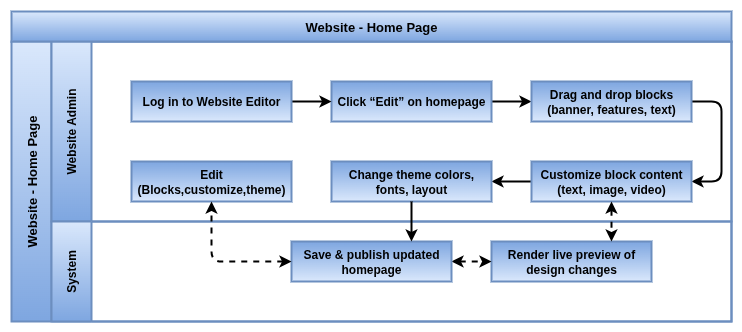
Key Points
- Intuitive drag-and-drop editor for easy page building without coding
- Over 80 pre-designed content blocks like banners, text, images, videos and forms
- SEO optimization tools built-in for better search engine rankings
- AI-powered multi-language support to reach a global audience
- Responsive design ensures content looks great on all devices
- Real-time preview and easy publishing process
- Supports various content types About Us, Blogs, FAQs, Case Studies and more
- Integrates seamlessly with marketing and CRM tools for lead generation
- Role-based access control for collaborative content management
- Fast and smooth performance with optimized media handling
Screenshot
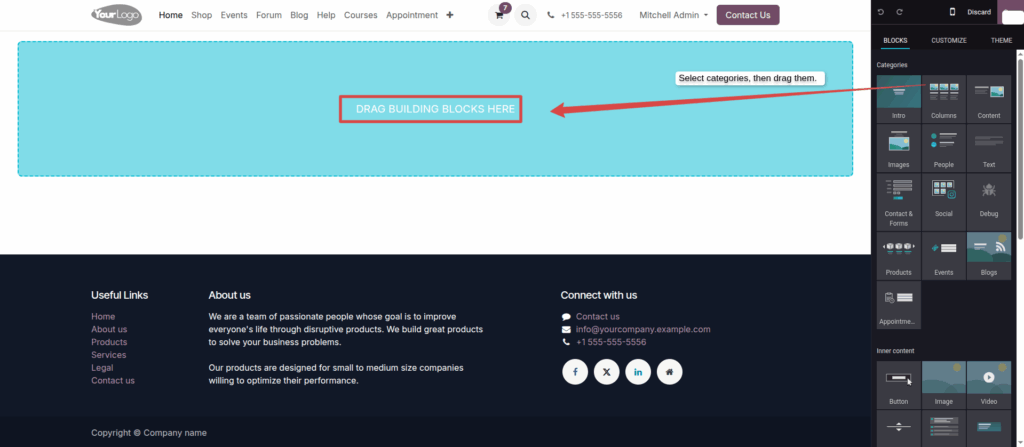
After dragging, multiple introductions, columns, and additional elements are generated


Menu Editor
Overview
The Menu Editor in Odoo Website lets you easily create and organize your website’s navigation without any coding. Using a simple drag-and-drop interface, you can add, remove, and rearrange menu items to build a clear, user-friendly menu structure that guides visitors effortlessly through your site. This flexibility helps improve user experience and keeps your website navigation aligned with your business needs.
Process Flow
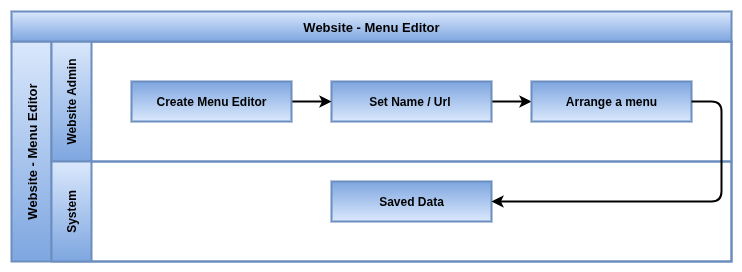
Key Points
- Drag-and-drop interface for easily adding, editing, and reordering menu items
- Supports multi-level menus with dropdowns and submenus for better organisation
- Menu items can be linked to internal pages, external URLs, or categories
- Real-time preview available before publishing menu changes
- Menu visibility can be controlled based on website, user roles, or other criteria
- Fully responsive menus that work seamlessly on both mobile and desktop devices
- Supports multiple websites with separate menu structures, if required
- Menu names should be clear and meaningful to improve navigation
- Changes should not impact website speed or SEO performance negatively
Screenshot
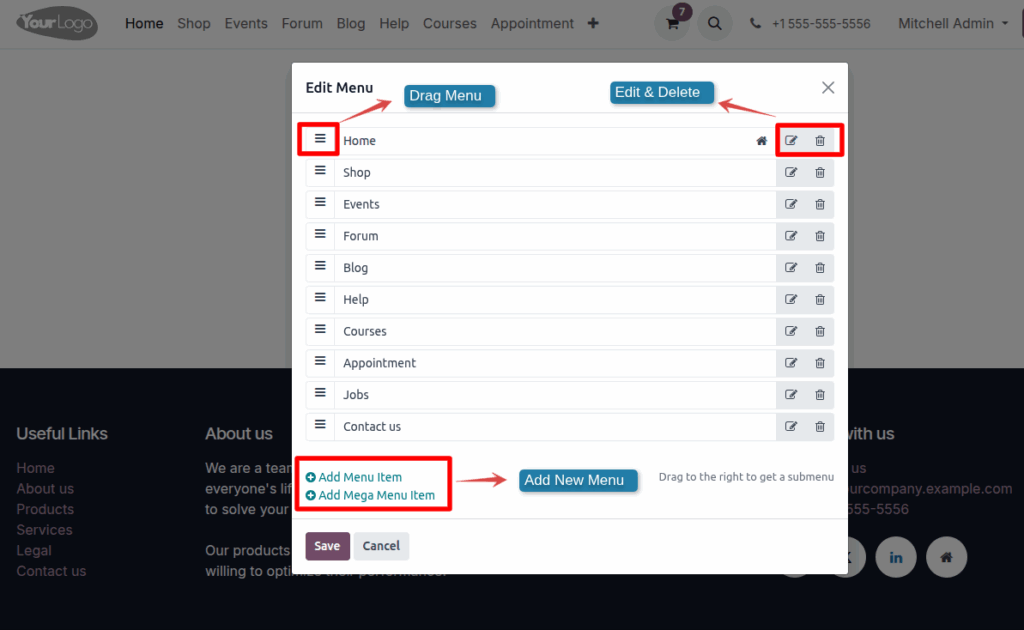
Content
Pages
Overview
Pages are the building blocks of an Odoo Website. They allow businesses to create and organise content such as Home, About Us, Services, Products, Blog, and Contact pages. With the drag-and-drop website editor, users can design responsive pages without any coding knowledge. Each page can be customised with pre-built blocks, optimised for SEO, and managed across multiple websites. Pages also support publishing controls, translations, and user-friendly layouts, making them essential for an engaging and professional online presence.
Process Flow
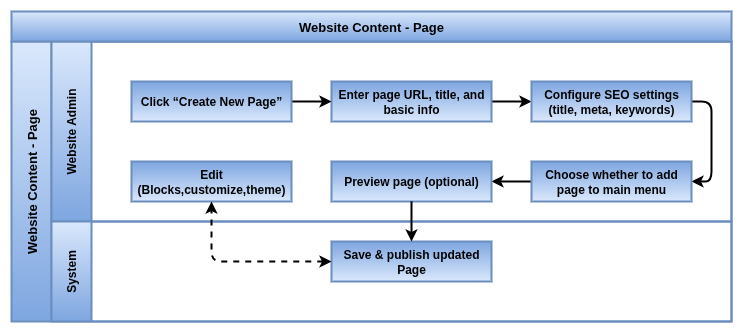
Key Points
- Clearly present your business story, services, and important information
- Build trust with customers through professional and organized content
- Easy-to-navigate layout helps visitors find what they need quickly
- Optimized to improve visibility on search engines
- Showcase FAQs to answer common customer questions upfront
- Provide contact details and calls to action that encourage engagement
- Use images and videos to make your message more compelling
- Help turn visitors into loyal customers with clear, confident messaging
- Create unlimited website pages with an intuitive drag-and-drop editor
- Use pre-designed content blocks for faster page building
- Control page visibility by publishing, unpublishing, or restricting to user roles
- Manage SEO settings (title, keywords, description, URL) for each page
- Multi-language support with AI-powered translation
- Add menus, banners, forms and multimedia content easily
- Duplicate pages for quick content reuse
- Schedule publishing of pages at a specific date and time
- Fully responsive design that works on mobile and desktop
- Integrates seamlessly with other Odoo apps (CRM, eCommerce, Blog, Forum, etc.)
Screenshot

Click the page line to modify the page and save.
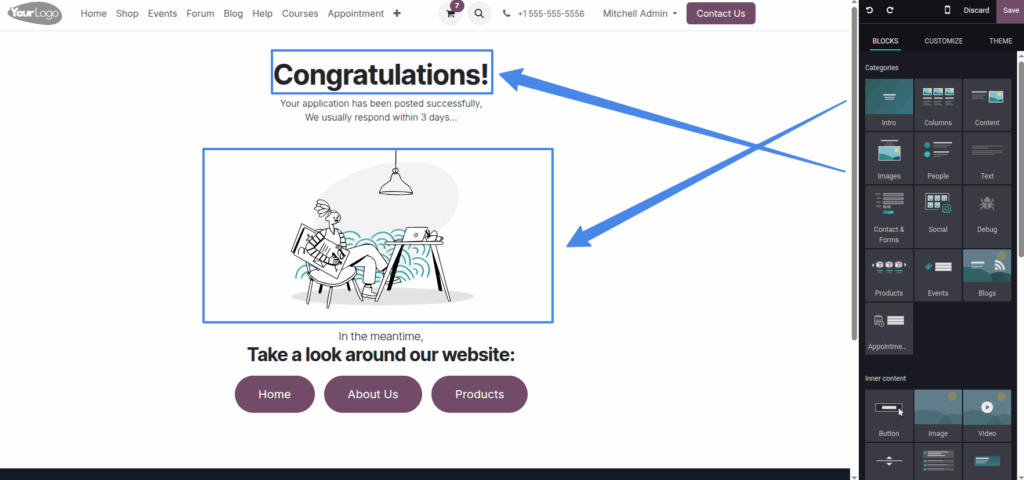
Blog Posts
Overview
The Blog Post module is part of the Odoo Website application, designed to allow businesses to create, manage, and publish blog content easily. It supports content marketing, SEO optimization, user engagement, and seamless integration with other Odoo apps such as CRM, Email Marketing, and Analytics.
Odoo Blogs are structured around categories, known as blogs, and posts are created under these categories. The system supports publishing workflows, media embedding, scheduling, and commenting.
Process Flow
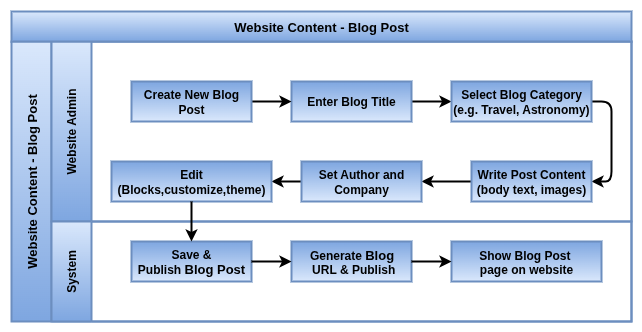
Business Rules
- Each blog post must have a unique title and URL slug to prevent duplicate entries
- Blog posts must be assigned to a specific blog (category), such as “Travel” or “Astronomy.”
- Posts are created in draft status and must be explicitly published to appear on the website
- Only users with “Publisher” or “Editor” roles can publish or approve a post for publication
- The author name is displayed publicly and is assigned automatically when the post is created
- Posts must be SEO optimized, including a meta title, meta description, and a clean URL slug
- Each blog post must include at least one featured image and descriptive alt text for accessibility and SEO compliance
- The published date is visible to users and reflects either the manual publish time or a scheduled time
- Admins can customize or add blog categories, such as creating new topics like “Science” or “Lifestyle.”
- Posts can be scheduled for future publishing, and they will automatically appear on the site at the set time
- The slug (URL segment) is auto-generated from the title but can be manually customized by the user
- Only published posts are accessible to website visitors; drafts and archived posts remain internal
- Blog posts can be archived but not deleted, ensuring historical content is preserved and accessible internally
- Readers can leave comments on blog posts (if commenting is enabled), and comments can be moderated by content managers
- Each post should have at least one call-to-action (CTA) (e.g., link to product, subscription form, contact button)
- Admins can extend blog functionality using Odoo Studio or custom modules (e.g., adding read time, author bios, related posts, etc.)
- Blog performance should be monitored regularly using analytics tools; low-engagement posts may be flagged for review or improvement
- Evergreen or high-traffic posts should be reviewed and updated periodically to maintain relevance and SEO ranking
Screenshot

Forum Post
Overview
The Forum enables community-based Q&A discussions on a website. Users can post questions, provide answers, vote on content, and interact through comments. The forum supports moderation, reputation (karma) systems, tagging, and categorization, making it a useful tool for support communities, internal knowledge sharing, and customer engagement.
It can be customized for public forums, internal company discussions, or customer self-service portals. The module is tightly integrated with the website, user roles, email notifications, and Odoo Studio.
Process Flow
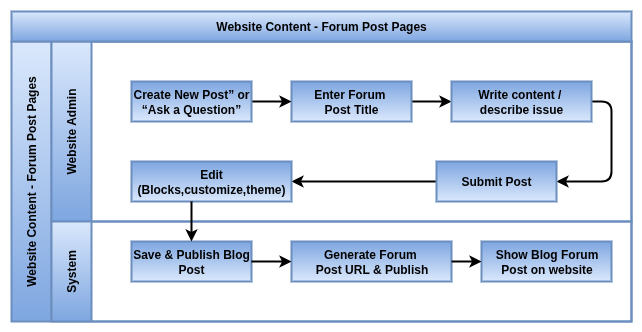
Business Rules
- Each forum post (question) must have a unique title to clearly distinguish it from others
- Forum posts must be assigned to a specific forum category (e.g., “Technical Help,” “Sales,” “General Discussion”)
- Only registered users can create or reply to posts (answers or comments)
- Posts are created with a visible status and appear on the site immediately unless moderation is enabled
- Moderators can close, delete, or edit any forum post at any time
- Posts that are closed must include a selected close reason (e.g., duplicate, solved, off-topic)
- The selected close reason must be visible to all users on the closed post
- Each close reason must have a unique label or description (e.g., “Duplicate Question”, “Not Relevant”)
- Admins can create, customize, or extend the list of available close reasons
- Each forum post can receive answers, and one answer can be marked as “Correct Answer” by the original poster or a moderator
- Users can comment on both questions and answers to request clarification or provide feedback
- Forum content can be voted up or down by users to surface helpful content
- Karma points are awarded to users for posting questions, answers, or receiving upvotes
- Users gain permissions based on karma thresholds (e.g., ability to comment, vote, or moderate)
- Flagged content is sent to moderators for review and can be hidden or removed if it violates community rules
- Only published or open posts are visible to website visitors; archived or deleted posts are hidden
- Admins can manage forum categories, tags, user permissions, and karma levels
- Forum performance and engagement should be reviewed regularly to ensure active moderation and content quality
Screenshot

Products
Overview
The Products section is designed to showcase a company’s offerings in a clear and attractive manner. It enables visitors to explore, compare, and select products that best suit their needs. Well-structured product pages with rich images, detailed descriptions, specifications, and pricing details build customer confidence and create trust. Smooth navigation, filtering, and responsive layouts ensure a seamless browsing experience. By presenting products in an engaging way, businesses can highlight their value, increase customer interest, and ultimately drive more conversions
Process Flow
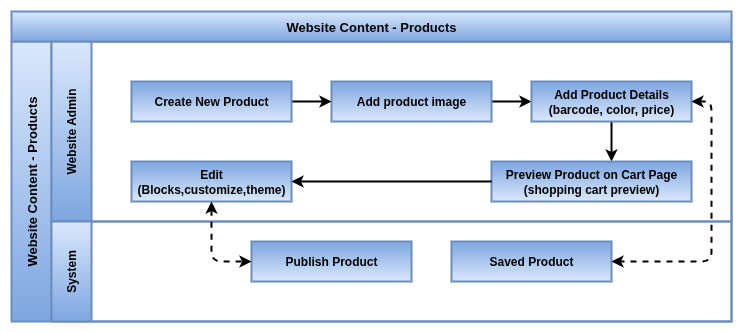
Key Points
- Display products with high-quality images and clear descriptions
- Organize products into categories for easy browsing
- Provide essential details like pricing, features, and availability
- Include customer reviews or ratings to build trust
- Enable filters and search to help customers quickly find what they want
- Mobile-friendly design ensures seamless shopping on any device
- Integrate with the shopping cart and checkout for smooth purchase flow
- SEO-friendly product pages improve search rankings and organic traffic
- Highlight promotions, discounts, or best-sellers to attract attention
- Keep product information up-to-date for accuracy and reliability
Screenshot
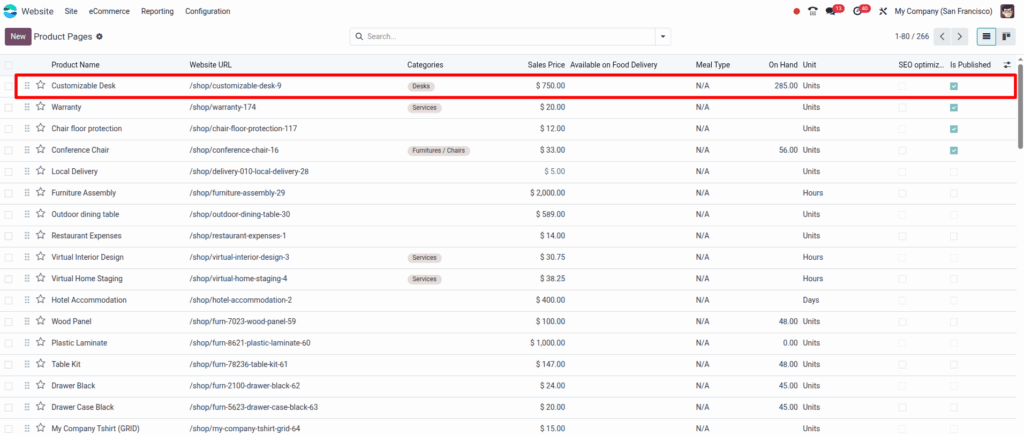

Events
Overview
The Events section helps you showcase upcoming workshops, webinars, seminars, or special occasions that engage your audience and build community. By providing clear details, easy registration options, and timely updates, this section encourages visitors to participate and stay connected with your brand. Well-presented event pages boost attendance and foster ongoing relationships with customers
The Events section of the website allows businesses to promote, manage, and share upcoming events directly with their audience. It provides a professional way to publish event details such as agenda, speakers, venue, date and time, along with images and promotional content. Visitors can browse upcoming events, register online and even purchase tickets if integrated with eCommerce. With responsive layouts, event pages look attractive across devices, while built-in tools support event marketing, reminders, and attendee engagement. This feature ensures seamless event visibility and smooth registration management through the website
Process Flow
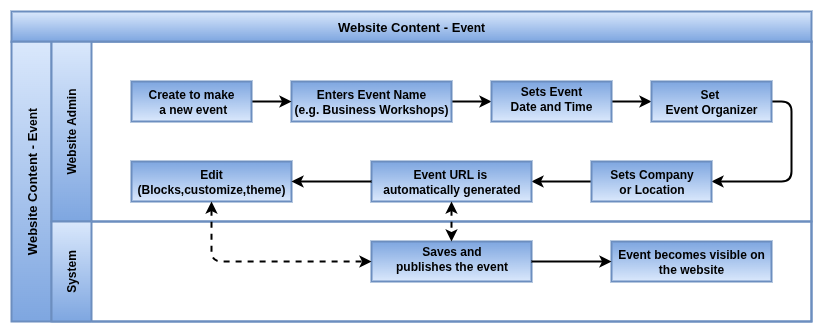
Key Points
- Display event details clearly date, time, location, and description
- Easy-to-use registration or booking forms to capture attendee information
- Highlight featured or upcoming events prominently to attract interest
- Integrate calendar views or countdown timers for better visibility
- Mobile-friendly design to ensure accessibility on all devices
- Send automatic reminders or confirmations after registration
- Allow event sharing on social media to increase reach
- Support for online and offline events with relevant links or directions
- Track attendance and manage event participants efficiently
- Use engaging visuals like banners, photos, or videos to promote events
- Allow online registration with customizable forms
- Integrate ticketing with payment options (free or paid events)
- Multi-website and multi-language support for global audiences
Screenshot

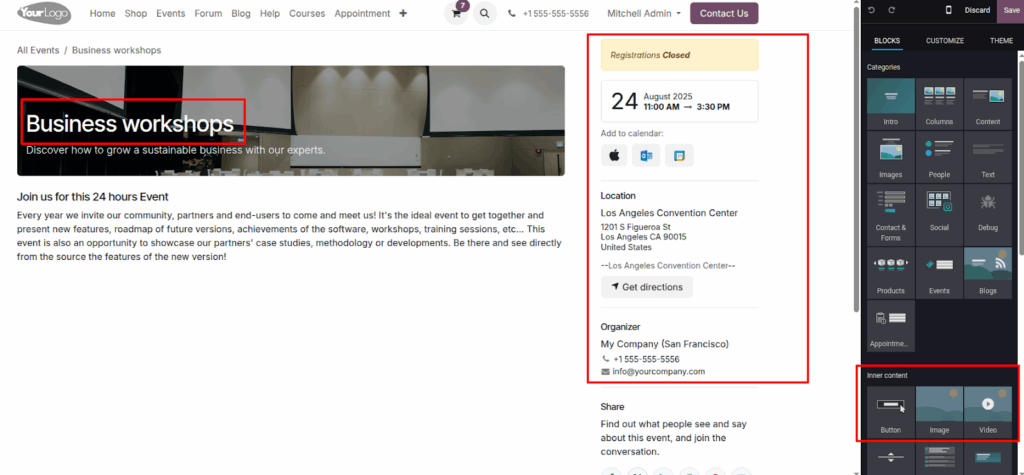
Courses
Overview
The Courses section (eLearning) helps businesses, schools, and trainers deliver structured learning content through their website. It provides a professional way to publish courses with lessons, videos, documents, and quizzes, making learning interactive and engaging. Learners can access content at their own pace, track their progress and earn certifications upon completion. With community tools like forums and reviews, learners stay connected and motivated. The system supports both free and paid courses, integrates with sales for monetisation, and provides analytics to measure learner performance and course effectiveness
Process Flow
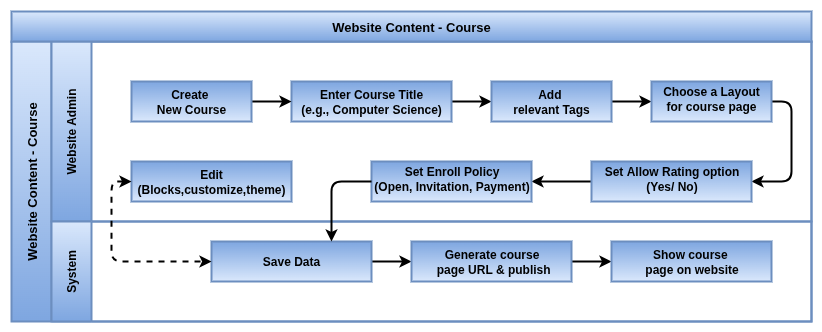
Key Points
- Clearly present course details syllabus, duration, schedule and fees
- Easy enrollment or registration process for prospective students
- Use engaging descriptions and multimedia like images or videos to explain courses
- Highlight key benefits and outcomes to attract learners
- Mobile-friendly layout for access on any device
- Support for multiple course formats online, in-person or blended
- Provide reviews or testimonials from past students to build credibility
- Enable course tracking and progress monitoring for enrolled users
- SEO-optimized pages to attract organic traffic from search engines
- Integration with payment gateways for seamless transactions
- Create courses with multiple lessons, chapters, and sections
- Support for multimedia content: videos, documents, slides and links
- Add quizzes, assignments, and assessments to test knowledge
- Offer free or paid courses with integrated payment options
- Allow learners to track their progress and view completion status
- Award certificates automatically after course completion
- Enable discussions, reviews, and feedback for better engagement
- Manage access rights (public, members-only, or restricted groups)
- Support drip content (scheduled lesson release)
- Provide detailed analytics on learner performance and course popularity
- Mobile-friendly design for learning anytime, anywhere
Screenshot

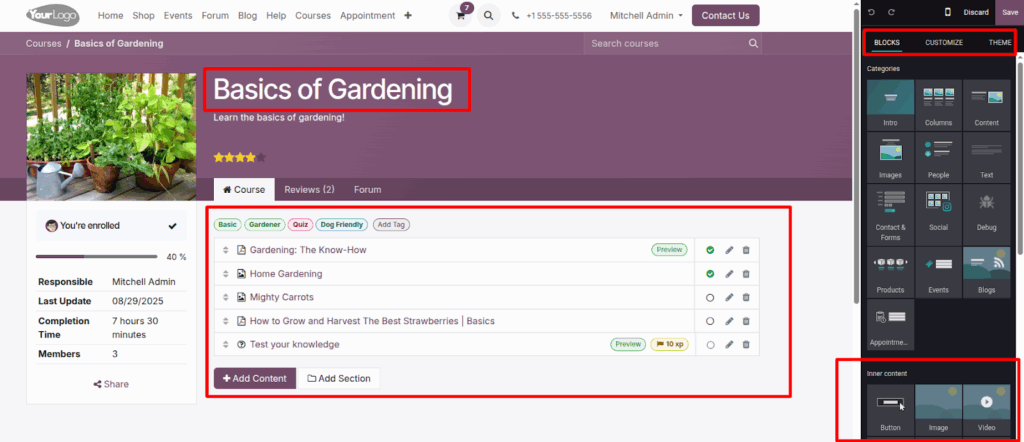
Appointment
Overview
Odoo Appointment Pages offer a seamless and efficient way to manage bookings across various services such as dental care, fitness training, online cooking classes, recruitment interviews, and tech consultations. Each booking page is customizable to fit the specific needs of your business, providing real-time availability, automated notifications, and regional restrictions. This ensures a smooth experience for customers and easy management for your team, boosting engagement and operational efficiency.
Process Flow

Key Benefits
- Custom booking pages for diverse services like Dental Care appointments, Tennis Court reservations, Online Cooking Lessons, Job Interview scheduling, and Tech Meet consultations
- Real-time availability display lets customers instantly find and book open slots, minimizing scheduling conflicts
- Geo-targeting options restrict bookings by country or region, ideal for businesses operating across multiple locations
- SEO-optimized pages attract relevant local customers and increase online visibility
- Supports both in-person and virtual appointments to accommodate all customer preferences
- Automated email/SMS confirmations and reminders reduce no-shows and improve customer experience
- Easy rescheduling and cancellation features empower customers to manage their appointments hassle-free
- Mobile-friendly design allows bookings anytime, anywhere, on any device
- Integration with Odoo calendars and CRM for centralized appointment and customer management
- Enterprise-level security and data protection keep sensitive information safe and compliant
Screenshot

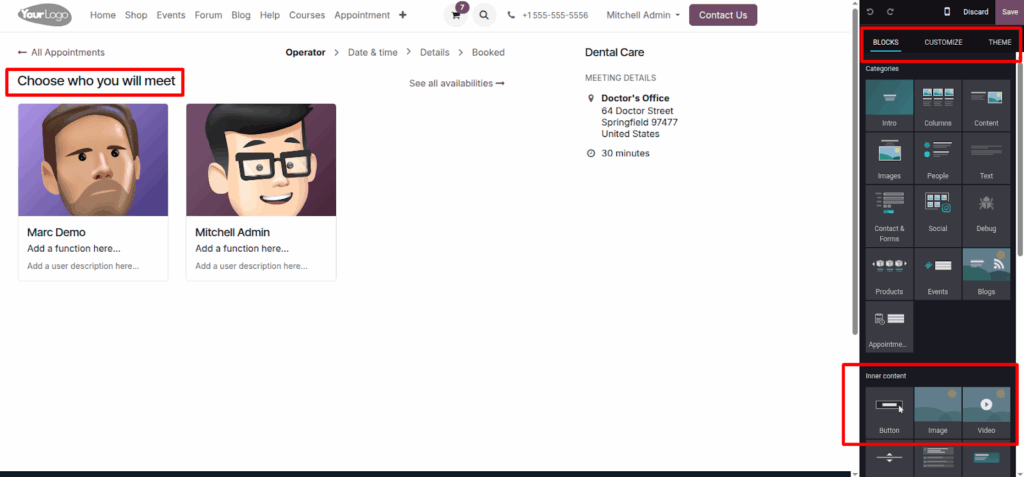
Jobs
Overview
The Jobs section helps you attract the best talent by showcasing your current openings clearly and professionally. It provides an easy way for candidates to explore job opportunities, submit applications, and track their status. Integrated with your recruitment processes, this section streamlines hiring while presenting your company as an attractive workplace.
Process Flow
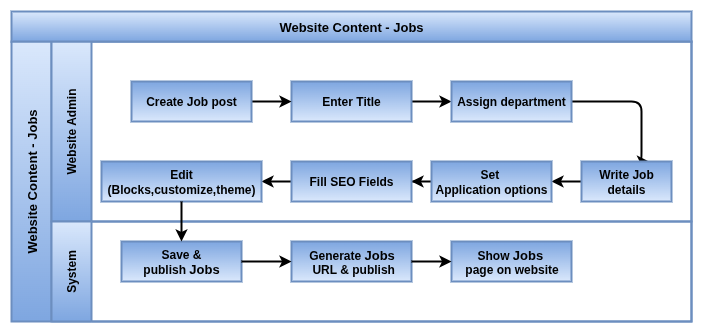
Key Benefits
- Display current job openings with detailed descriptions and requirements
- Simple and user-friendly online application submission
- Customizable job pages to match your brand and attract the right candidates
- Automated notifications keep applicants informed of their application status
- SEO-optimized job listings to reach a wider and more relevant audience
- Mobile-friendly design ensures easy browsing and applying from any device
- Integration with Odoo’s recruitment tools for seamless candidate management
- Ability to filter and search jobs by location, department, or role
- Secure handling of applicant data to maintain privacy and compliance
- Highlight company culture and benefits to attract top talent
Screenshot

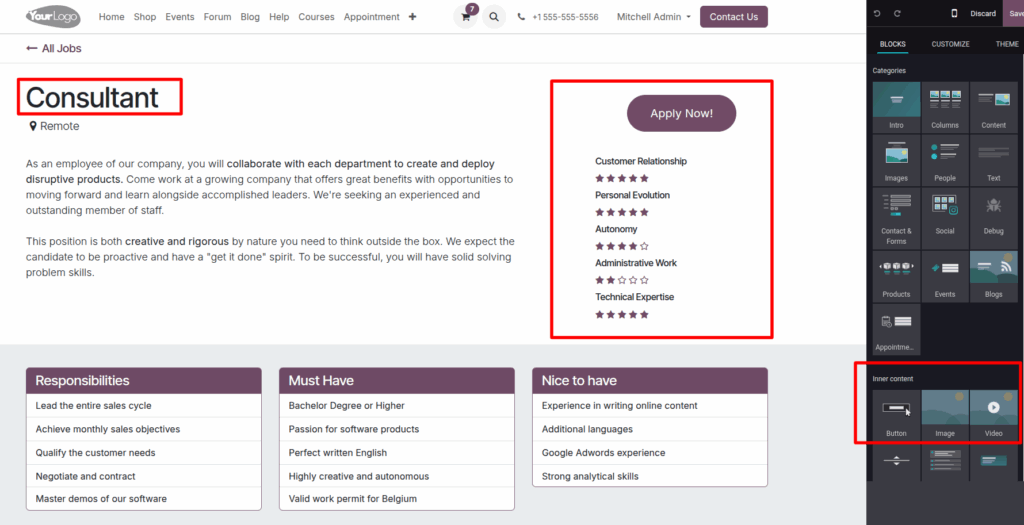
Website configuration Management
Website
Overview
Website Configuration lets you easily create and manage multiple websites under your brand, each tailored to different markets, languages, or locations. Whether you need one site or several, you can customize content, languages, and settings to deliver a unique experience to each audience, all from a centralized platform.
Process Flow
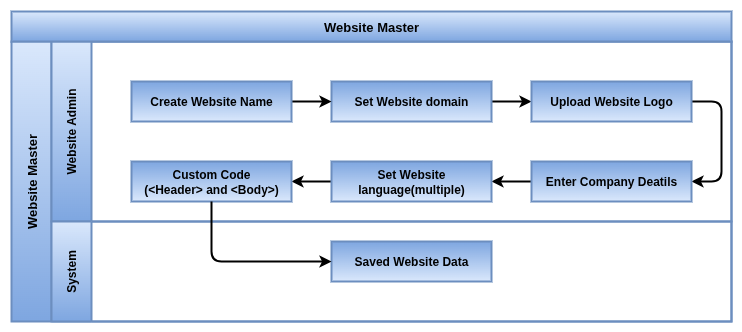
Key Benefits
- Manage multiple websites from a single dashboard for better control and efficiency
- Customize each website with its own language, location, and branding
- Target specific markets or regions by tailoring site content and settings
- Consistent user experience with easy navigation and design control across sites
- Simplified site management reduces admin overhead and speeds up updates
- Support for multilingual content to reach global audiences
- Integration with other Odoo apps for seamless business operations
- Quickly switch between websites for fast editing and monitoring
- SEO and performance settings optimized individually for each site
- Ensure brand consistency while addressing local customer needs
Screenshot

Website Menus
Overview
Website Menus in Odoo let you organize your site’s navigation clearly and efficiently. Whether you run one or multiple websites, you can create custom top menus that guide visitors to important sections like Home, Shop, Events, Courses, Appointments, Jobs and Contact pages. This structured navigation enhances user experience, helping customers find what they need quickly and boosting engagement.
Process Flow
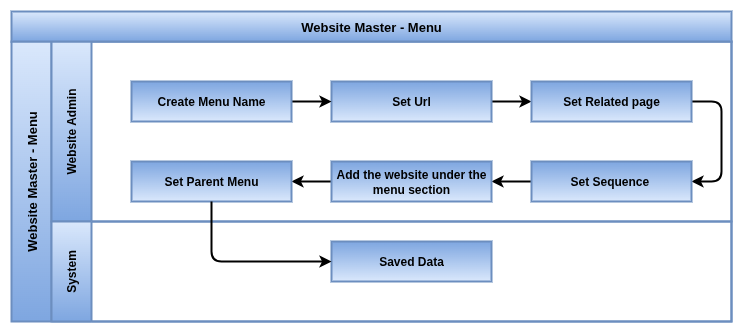
Key Benefits
- Create custom menus for each website to reflect different branding or content strategies
- Organize menus with clear labels like Home, Shop, Events, Courses, Appointments, Jobs, and Contact Us for easy visitor navigation
- Use mega menus or standard menus to display multiple links in a user-friendly layout
- Assign menu items to specific groups or websites for targeted visibility
- Menus support direct linking to pages, product categories, events, or external URLs
- Easy drag-and-drop interface to add, remove, or reorder menu items without technical skills
- Menus are fully responsive and mobile-friendly, ensuring smooth navigation on all devices
- Multi-website support allows managing separate menus for different markets or languages from one platform
- Enhance SEO by structuring menus that help search engines understand your site better
- Preview menu changes live before publishing for a polished website experience
Screenshot
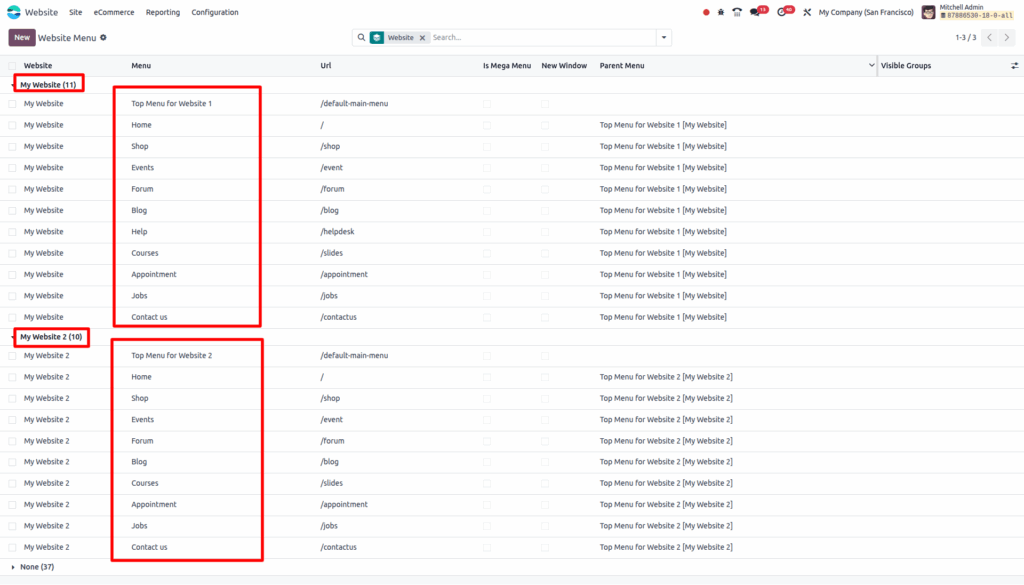
Website Reporting Management
Visitor Reporting
Overview
The Visitor Reporting feature in Odoo Enterprise Edition offers real-time monitoring and detailed insights into website visitor activity. It tracks user behavior, visit frequency, engagement patterns, and conversion paths, enabling businesses to understand their audience and improve lead generation. Deeply integrated with Odoo’s CRM, Live Chat, and Marketing Automation modules, it allows for proactive communication, lead tracking, and personalized customer engagement.
This feature supports both anonymous and known visitor tracking and is ideal for marketing, sales, and support teams looking to optimize customer journeys and conversions.
Key Features
- Tracks each website visitor with a unique session ID, even before identification
- Displays a real-time list of active and recent visitors
- Logs each visitor’s first connection and last connection timestamps
- Captures total number of visits per user (visit count)
- Logs visitor’s entry page, last page visited, and total visit duration
- Records total number of pages visited during a session
- Identifies the visitor’s device type (desktop, mobile, tablet) and browser version
- Collects geolocation data such as country and city based on IP address
- Distinguishes between new and returning visitors
- Links visitor activity to CRM leads or opportunities when forms are submitted or chats are started
- Tracks whether a visitor initiated or responded to a live chat
- Allows users to send a chat request proactively from the backend (sales or support team)
- Displays chat status ongoing, completed, or missed
- Flags internal user sessions (e.g., admin or employee visits) to exclude them from analytics
- Links visitor data to existing CRM contacts if previously identified
- Stores complete visit history for known contacts within their CRM record
- Integrates with lead scoring to trigger alerts or workflows based on visitor behavior
- Segments visitors based on behavior (e.g., visited pricing page, multiple returns)
- Tracks conversion events (e.g., form submissions, chat starts, email opt-ins)
- Includes visitor metrics and KPIs in the website performance dashboard
- Supports exporting of visitor logs in Excel or CSV formats
- Integrates with Marketing Automation to trigger campaigns based on visit behavior
- Ensures GDPR compliance with cookie consent and anonymous tracking options
Screenshot
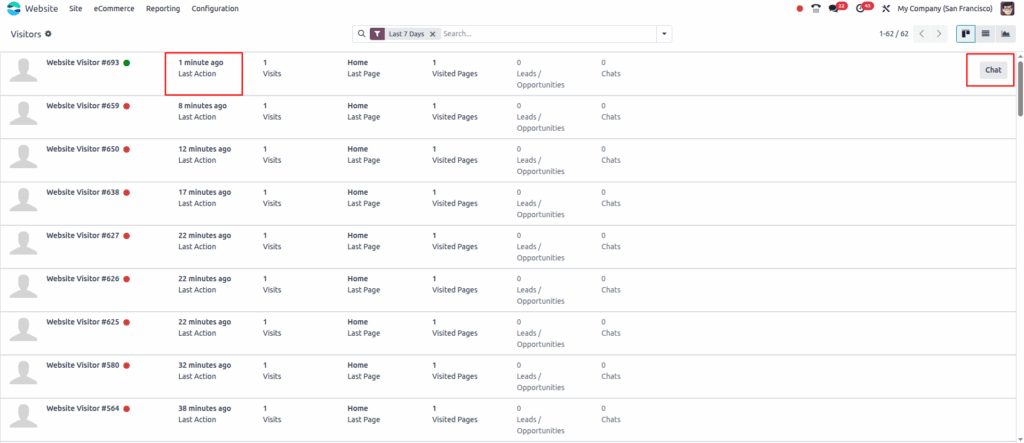

Page views
Overview
The Page Viewer is a powerful analytics tool integrated within Odoo Enterprise Edition that tracks and displays visitor interactions with your website or web application in real-time. It provides detailed logs of page visits, including which URLs were accessed, by whom and when. This tool is essential for understanding user behavior, optimizing site navigation and improving the overall user experience.
Key Features
- Comprehensive Page Tracking Records every page visit along with timestamps, visitor identity and URL details
- User Identification Differentiates between logged-in users (e.g., admins, registered customers) and anonymous visitors for targeted analysis
- Session and User Activity Logs Enables tracking of continuous user sessions, showing the flow from one page to another during a visit
- Filtering and Grouping Allows filtering by visitor, page, URL, product, and date to narrow down analysis. Grouping options help summarize data by key dimensions
- Real-Time Monitoring Tracks live user activity, giving immediate insights into website usage patterns
- Customizable Views Supports saving custom filters and grouped views as favorites for quick access to frequently used reports
- URL and Page Specific Analytics Displays which specific pages or product URLs are most visited, helping identify popular content or products
- Visitor Engagement Insights Shows repeated visits and navigation patterns to detect user interest or friction points in user journeys
- Integration with Other Modules Works seamlessly with Odoo modules like eCommerce, Appointments, and Contact forms for a unified visitor analytics experience
- Debug Mode Tracking Monitors activity in debug mode, useful for developers and administrators troubleshooting or testing site behavior.
Screenshot
